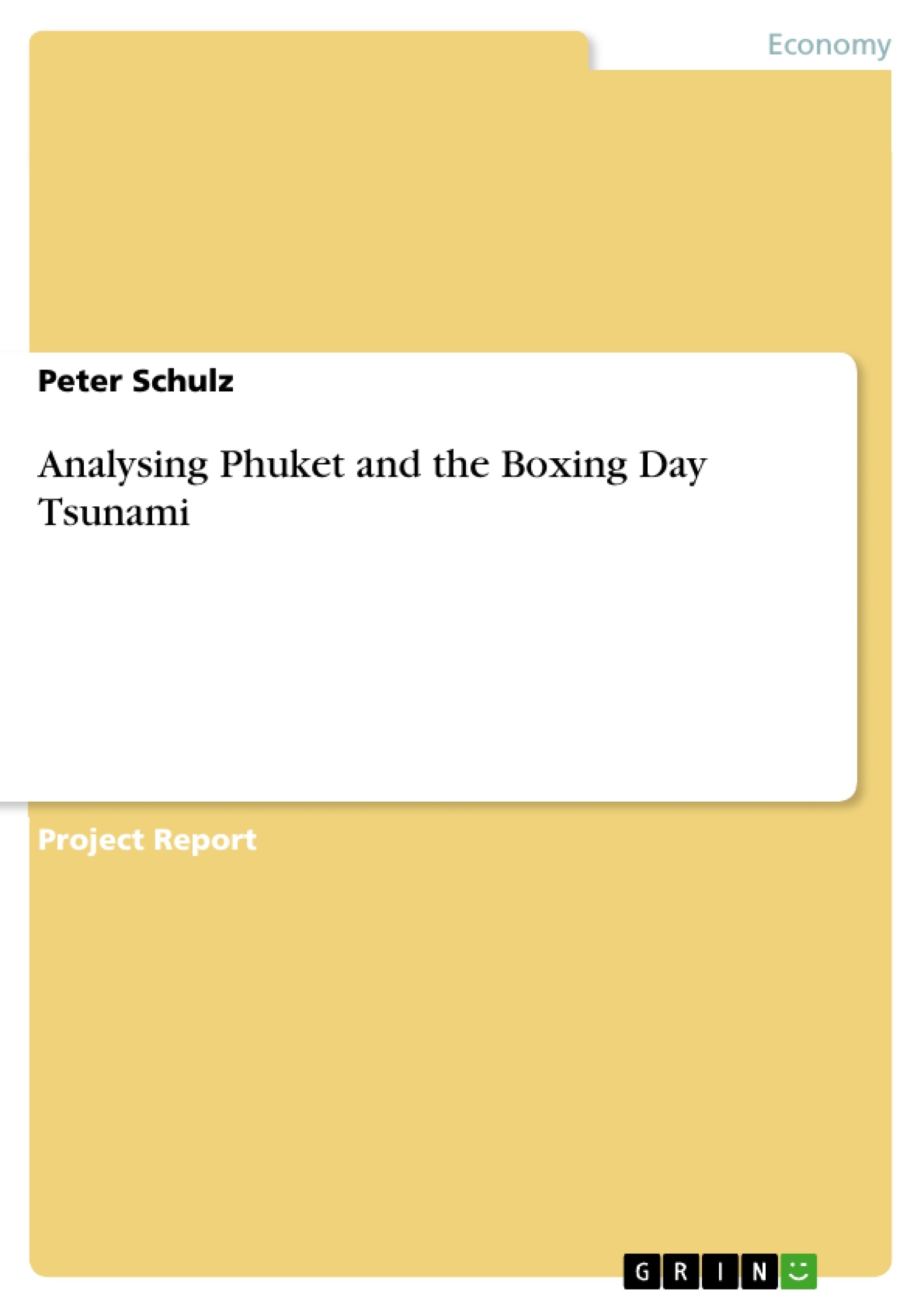Excerpt
Introduction
This report examines the destination of Phuket with regard to the evolution of the tourism industry until 2004 as research allows a clear picture for this time due to the availability of data. Concepts of accessibility, availability and stability will be presented before proceeding to analysing Phuket’s attractions. A classification into a destination lifecycle and government policies are introduced before summarising the destination.
The next chapter describes the Boxing Day Tsunami and its effects on Phuket before continuing to evaluate which measures the destination has taken to counter-steer prevailing problems. Finally, Phuket’s behaviour will be compared to other destinations that have suffered similar external shocks before concluding with an outlook for tourism in Phuket.
Phuket as a tourist destination
Phuket is Thailand’s largest and most visited island. Dubbed ‘Pearl of the Andaman’ (Royal Orchid Holidays, 2007), Phuket thrives on tourism and is Thailand’s number two destination. About 90% of the population is directly or indirectly engaged in tourism-related businesses (Ichinosawa, 2006) and the fact that tourism contributes 42% to the island’s GDP (Birkland, 2005) make it not surprising for tourism to be described as Phuket’s lifeblood (Beyette, 2006).
Analysing the evolution of tourism, the industry has gone a long way: Phuket’s traditional role as a source of raw material began to erode in the 1970s when marketing of the island as a destination began. The first hotel was built in 1976 and by 1979, the International Airport had been constructed by the Thai government. Phuket’s swift transformation into a typical mass tourism seaside resort destination (Kontogeorgopoulos, 2004) led to an abrupt increase in international tourist arrivals: following an estimated 20,000 visitors in 1976, this number had reached more than 8.9 million visitors in 2004 (Bangkok Post, 2007).
As far as accessibility is concerned, access by air is guaranteed through Phuket International Airport and is complimented by facilities that allow international cruise ships to stop in Phuket. Political access is hardly restricted as completing an arrival card will ensure a tourist visa upon arrival. Natural resources such as beaches or national parks are readily available and also accessible.
Availability is provided by numerous airlines offering domestic as well as international nonstop flights to Phuket. There are direct flights from within Asia as well as Europe and Australia. Cruise ships frequently stop in Phuket, securing further tourists into the island (Star Cruises, 2007). Accommodation ranks from low-budget to five-star luxury hotels and a range of services required is supplied.
From a social, political and economic perspective, Phuket can be regarded as a stable destination. In spite of social unrest in Thailand’s South and political turmoil in Bangkok, Phuket remains largely unaffected and enjoys the image of a safe location (Is Phuket Safe?, 2007). As far as affordability is concerned, the majority of accommodation and activities in Phuket is deemed affordable. The local currency converts favourably for most international tourists, thus adding to a low total cost of a holiday on this island. According to the Deloitte Hotel Benchmark Survey, the average room rate in 2004 was 4,049 THB (PATA, 2005) which corresponds to 130 A$, showing that Phuket offers good value for tourists compared with other tropical destinations (Birkland, 2005).
Phuket’s attractions have been described to be of the “stereotypical sun, sand and sea variety” (Kontogeorgopoulos, 2004, p. 2). A brochure from Royal Orchid Holidays (2007) refers to a diverse range of natural attractions and activities, including island cruises and sailing, mangrove canoe trips, lounging at the beach and relaxing in a spa. The beaches are “as good as they get” and Birkland (2005) adds that Phuket possesses some of the most beautiful beaches in the world.
Phuket is also the hub for trips to surrounding islands such as Phi Phi Island or Koh Yao Noi. In addition, antique buildings such as temples, various museums and aquariums as well as various national parks are highlighted as attractions (Amphoe Muang, 2007).
Not extensively dubbed an attraction is Phuket’s vibrant nightlife. Particularly in the Patong area, entertainment hotspots add a fourth “S” to the destination, with sex complimenting sun, sand and sea. This is well-established with potential visitors to the island but marketing is kept at a minimum.
Using a classification of attractions presented by Laesk (2003), the variety of attractions in Phuket does not allow for all attractions to be classified similarly. However, given the clear focus of attractions in Phuket to be associated with sun, sand and sea as the pull-factors, these are in public ownership, free and natural, with the exception of tours and nightlife options which are privately owned, paid and unnatural. Target markets are manifold as Phuket attracts local, domestic and international visitors.
Classifying the attractions as above leads to imminent problems as none of the attractions is unique. Moreover, this kind of attractions can be found in other destinations as well, making Phuket substitutable and posing a significant problem. This will be analysed in detail in one of the following chapters when the island’s response to the Asian Tsunami will be analysed in-depth.
In order to position Phuket in a life-cycle model, the Butler destination area life-cycle (1980) is used. According to this model, pre-Tsunami Phuket would be in the consolidation phase of development, identified by still growing visitor numbers at declining rates.
As a final tool of analysing the destination of Phuket, government policies clearly appear to be pro-tourism: Phuket as a destination was pushed by the Thai government in the 1970s, for example shown by the government providing financing and constructing Phuket International Airport, thereby boosting tourism in Phuket. In addition, Thailand’s as well as Phuket’s Tourism Authority are government-run bodies promoting and marketing Thailand in general and Phuket in particular as destinations in overseas markets.
[...]
- Quote paper
- Peter Schulz (Author), 2007, Analysing Phuket and the Boxing Day Tsunami, Munich, GRIN Verlag, https://www.grin.com/document/113707
Publish now - it's free






















Comments